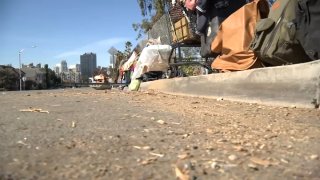
Butch Larson has been homeless for more than a decade. He's set up camp across from Hampton Inn on Cherry Avenue near the Guadalupe River in San Jose, a spot he's called home for three years that will be swept sooner than later.
His makeshift home is a large tarp held up by sticks, his floor covered with rugs and packed with dirt. Larson, 50, sits on a torn up couch and eats a plate of salmon over rice that a volunteer has left him. It's not an ideal situation, but it's the best he can manage at the moment. He's been on the housing waitlist for three years, he said. He came to San Jose in 2011 for vacation, but ended up spending a year in jail. His life hasn't been normal since.
"All I want to do is go back home," Larson, who is originally from South Dakota, told San Jose Spotlight.
San Jose Mayor Matt Mahan says all homeless people living by the creeks must go, claiming the San Francisco Bay Regional Water Quality Control Board could fine the city $60,000 per day for every pollutant found in the waterways. In February, the water board denied the city a stormwater permit because it was found to be noncompliant.
The city is looking to reallocate funds to help pay for shelter and services for homeless residents living along the waterways, who need to be cleared out by June 2025. But multiple unhoused people feel that once they are swept from the river, they're just going to have to find another place in the city to set up camp.
"It feels like (the rug is) being yanked out from underneath us," Robert Howarth, a homeless resident who has set up his tent near Larson, told San Jose Spotlight. "So where do I go? What neighborhood do I pollute next? I'd kill to get a house."
Mahan said roughly 90% of pollution in creeks and rivers is caused by homeless encampments, and in February the city approved a plan to sweep multiple homeless camps along the Guadalupe River Trail and bar unhoused people from returning.
Local
However, the city has been overstating the amount of penalties it faces. A water board official previously told San Jose Spotlight that maximum fines top at $10,000 per day, but even then, these fines are reserved for the most severe violations.
Additionally, Environmental Protection Agency spokesperson John Senn said the $60,000 figure refers to the maximum civil penalty under the Clean Water Act for each day of a distinct violation. But the EPA's Pacific Southwest office has not assessed any penalties to cities associated with discharges from homeless encampments.
Get a weekly recap of the latest San Francisco Bay Area housing news. Sign up for NBC Bay Area’s Housing Deconstructed newsletter.
The unhoused residents near the creeks aren't the only ones polluting the waterways. Last year, construction firm Graniterock paid $325,000 to settle a lawsuit alleging the company polluted Coyote Creek by allowing stormwater runoff contaminated with heavy metals to flow into it, threatening steelhead trout and other animals.
No place to go
Without housing and supportive services, homeless residents along the waterways will relocate to another part of the city.
There's not enough shelter beds for all the people living at the waterways, and shelters in the city are often "jam packed," homeless advocate Scott Largent told San Jose Spotlight. There were 900 emergency shelter beds in the city in 2019, according to a Department of Housing and Urban Development study -- though San Jose has ramped up efforts to house homeless residents. Since then the city has built six emergency interim housing sites with 437 beds.
But for every one person housed nearly two become homeless in Santa Clara County. The county's 2023 biennial count of homeless people reported San Jose has 6,340 unhoused residents, 4,411 of whom live on the street, along rivers or in tents. This number doesn't paint the full picture of homelessness in the city, as it only measures people experiencing homelessness on a single night. The survey is often considered an undercount.
Largent has noticed more homeless people congregating at St. James Park and other parts of downtown, and said more people will occupy the streets and parks once the waterways are swept.
"I think they just gotta get more creative on where to go," Largent told San Jose Spotlight. "In previous sweeps, not everyone was able to be housed."
At the encampment, Larson's chihuahua Bandit rips through the grass, wagging his tail and greeting others living there. The dog has stayed faithfully by Larson's side through every sweep. Larson said he loses most of his belongings whenever the city sweeps an area, forcing him to start all over again.
Now with the pressure to clear out of where he's lived for three years, he doesn't know where he will go next. He had an interview for housing not long ago, but his phone was just stolen.
"What can I do?" Larson said.
This story was originally published by San Jose Spotlight and provided by Bay City News.



